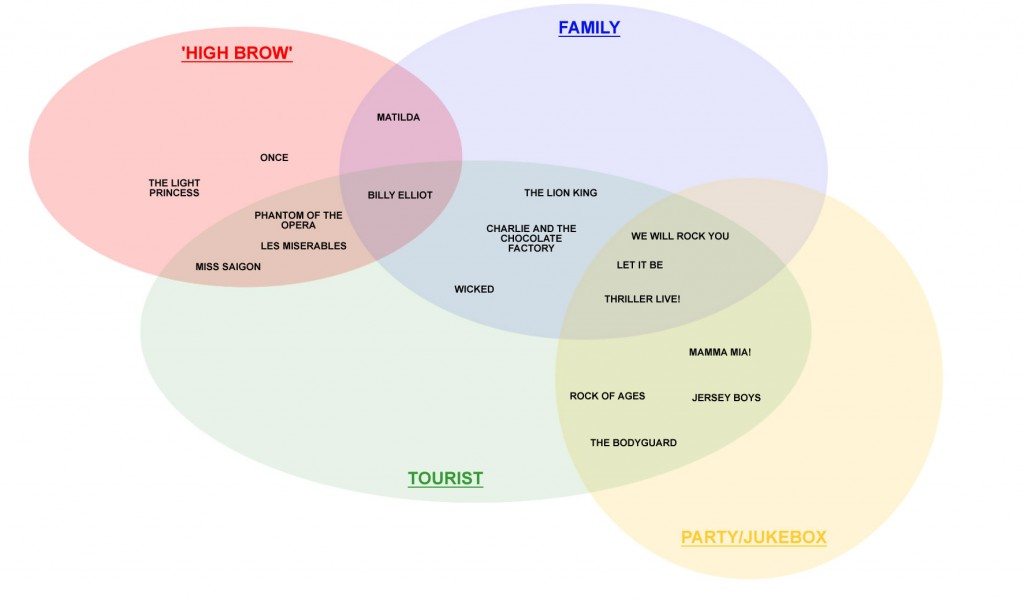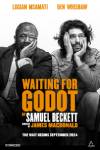Changing Face of London Theatre Marketing
Knowing Your Product
One of the first things you need to understand when marketing is your product. No matter what this product is, be it washing powder, jeans or a musical, if the creatives behind it don’t know what it is (or trying to be) then that message will never be successfully conveyed to the consumer. When planning new shows in the West End, Producers and investors must carefully consider not just their own ‘product’ but perhaps more importantly, the competition. With ticket prices constantly being inflated, it is now more important than ever before to respond to changes in the market and react accordingly in order to make a commercial success.
The London theatre market is an ever changing one, and every few years it shifts significantly according to audience expectation and the changing trends of theatre goers. As the Ticketmaster audience report recently revealed, theatregoers are becoming younger, and so the industry itself is beginning to reflect this. After years of ventures aimed at getting new audiences into the theatre by creating different types of work to appeal to the broadest markets possible, the current West End is now heavily weighted towards the non-traditional theatre goer. During the boom of the 1980s, musical theatre as an art form was seen to be a lot more mainstream, with cast recordings and even singles released into the UK pop charts. Andrew Lloyd Webber led much of this from the front, after successes with the albums of early works such as Jesus Christ Superstar and Evita crossing over into mainstream music. This formula was more recently used in 2004 when a pop version of ‘I Believe My Heart’ from the Lord’s new musical The Woman in White was released into the UK pop charts, reaching #2.
[soundcloud url=”https://api.soundcloud.com/tracks/86924172″ width=”100%” height=”166″ iframe=”true” /]
The music industry has changed almost beyond recognition since the last Lloyd Webber musical, and it is interesting to see his latest musical Stephen Ward once again using more mainstream channels to create mass appeal. Soundcloud and YouTube are two online music platforms that continue to grow year on year, and this is being used to great effect by upcoming musicals to engage a new audience. Reaching out to new audiences broadens the appeal, in what could be considered to have a particularly niche market.
West End Market Base
Looking at the current shape of the West End in the broadest sense can lead to some interesting results regarding the success of shows targeted at different markets. This diagram takes into account 4 key markets and shows the overlaps involved with each:
- Family: Defined by shows that have a broad family market. Musicals that are suitable for children, and can be enjoyed by all ages on different levels. Perhaps the most sought after market and the most difficult to get right. Theatregoing as a family peaks around peak seasons such as school breaks and seasonal holidays.
- Party/Jukebox: These are shows that, as Mamma Mia proudly claims, ‘you already know you’re going to love’. Shows that appeal to the more casual theatre goer, likely to attend in groups (hen parties, birthday parties etc). These are built on existing successful brands such as a film names, music personalities or bands. A very tricky market to judge as there seems to be no formula in which take off and which end up as flops.
- Tourist: The largest group and in many ways the most lucrative. Shows with the widest tourist appeal achieve longevity, and these can easily cut across into different shows. Recognised ‘product’ names help, and it often takes time for some shows to get into the tourist market. Shows that easily translate are the biggest winners in this category, and those that appeal to school groups fair even better. Tourists from England make up a significant amount of West End traffic, and their mind is usually made up by word of mouth, critics reviews and recommendations by friends and family.
- ‘High Brow’: These shows tend to attract non-traditional musical theatre goers and those who are more likely to see a play or other form. High critical praise, experimentation with form or even challenging subject matter can push shows into this category, which in some cases enjoy cross over with family and tourist shows. It is no coincidence that two of these musicals are produced by the RSC and National Theatre respectively.
In order to market to the largest number of people possible, and ultimately increase your overall chance of conversion, the general idea would be to cover as many bases as possible. Whereas some of the shows in the diagram are able to cover three bases, none manage to cross into all four. What the diagram proves is that the large cluster of musicals that cross over between the ‘tourist’, ‘family’ and ‘party/jukebox’ tend to have a better overall commercial shelf-life than those floating only in the ‘highbrow’ category.
One question that this must raise to those launching, or preparing to launch a new musical is to which of these demographics does the new ‘product’ want to appeal to. There is an interesting divide between those with critical success and Olivier Awards and those with the largest base market, so the real question raised is does a new show have to decide on which side of this fence it wants to be placed. Obviously there are key examples where critical and commercial success go hand in hand, but in more cases than not these do not marry up.

Opening Soon
Looking at the string of upcoming musicals again raises some interesting observations. Simon Cowell’s X Factor musical ‘I Can’t Sing!’ is certain to fall into three of the four categories, without even trying to be seen as ‘highbrow’. With a recognisable brand name at the forefront and an even more familiar creative team in the background it is almost certain to succeed. Viva Forever is perhaps one of the best examples of this method failing however, but whilst it used an extremely popular brand as a crutch, the substance was not enough to support it, and the show spectacularly failed to meet any of its key target markets. The script, characters and overall feel of the show tried to be something it wasn’t and ended up isolating audiences rather than appealing to them.
Andrew Lloyd Webber’s latest musical Stephen Ward is another interesting case in point. Whilst the prestige of Lloyd Webber and the subject matter of the piece tentatively places it within the ‘highbrow’ category, does this then mean that it will rely on critical acclaim in order to survive? The cast and creative team instantly raises it to a certain level with West End stalwarts such as Joanna Riding and Alexander Hanson leading the group. Stephen Ward is also an example where the marketing and artwork have been spot on. On the surface, the name of the show is quite exclusive – it relies heavily on previous knowledge of a certain subject in order to engage with it. It automatically rules itself out of hitting the ‘family’ and ‘party’ categories, and tourists will only come once it has proven itself. The artwork for the show is simple yet bold and effectively captures the essence of the 60s political drama.

Tim Rice’s new musical From Here to Eternity which opens officially on October 23rd is yet another example of how different media can be put to use. Their YouTube channel was used in the early days to introduce audiences to the creative team and background to the story.
Exactly where they fall in the spectrum above still remains to be seen. A lot of effort has been placed on emphasising that the show is based on the original James Jones novel rather than the film adaptation, moving it away somewhat, deliberately moving it out of the ‘party/jukebox’ category which houses most of the film-to-stage adaptations. Considering their marketing campaign, which features beautiful cast pictures and artwork, the show doesn’t seem to be marketed at tourists, and is certainly not a family show in the strictest sense. The question then remains, who is From Here To Eternity being marketed at? Some may say it is too early to say – and who knows, after the reviews are published the show may find itself forced to tap into a slightly different market in order to survive.
The most interesting observation this raises is how both From Here to Eternity and Stephen Ward exist almost in isolation as new traditional book musicals. Both are adapted from a source and are expected to be extremely traditional in form – staying true to the previous works of both Lloyd Webber and Rice. Book musicals of this form once made up the whole of the West End and Broadway, and now seem to be few and far between. As a result, new audiences who have been brought into the West End through musicals such as Ghost, Dirty Dancing and The Bodyguard can then struggle with the more traditional form of original book musicals, voting with their feet and ultimately bringing about their demise.
It’s positive to see some new marketing methods employed by From Here to Eternity, and although their target market may not be crystal clear, they are certainly going above and beyond that of most other new shows. Handing out Hawaiian leis to Londoners and encouraging them to tweet pictures of themselves in order to win a competition is an excellent and original way to promote engagement. A mobile backdrop currently travelling around London encouraged yet more photographs from the public (and the odd celebrity), bringing the warmth of the tropics to a dreary autumn city.










